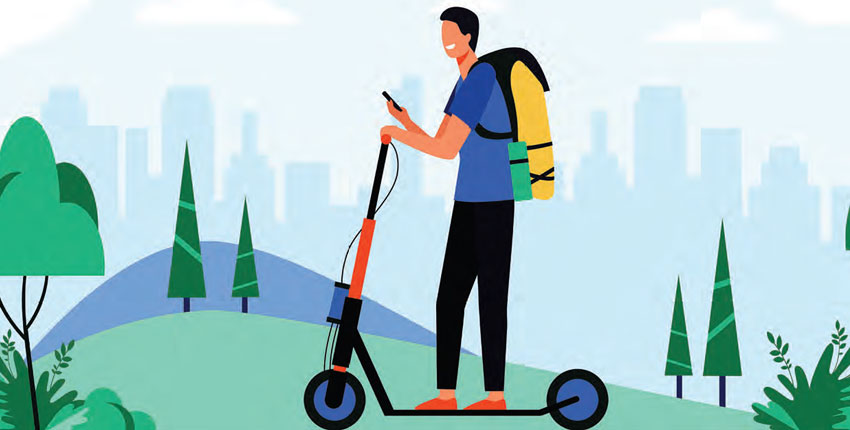The Road to Eco Transportation

The time has arrived to question the present fuel-based urban mobility system and foresee the potential of electric vehicles and eco-friendlier public transit infrastructure. At the recently held panel discussion presented by Avid Learning, titled “Sustainability NOW: The Road to Eco Transportation” expert panellists discussed the future of e-mobility, drone technology, alternate modes of public transit and low-carbon transport innovations.
Sharing insights on the need for sustainable and affordable transport alternatives, were Punit Goyal, Co-founder, BluSmart; Ashish Kundra, Principal Secretary and Commissioner Transport, GNTC, Delhi; Pawan Mulukutla, Programme Director, Clean Mobility and Energy Tech, WRI India; and Smit Shah, President, Drone Federation of India, in conversation with Rajiv Ramchandra, Founder, Re:CREATe
"In the larger context of pollution and environmental sustainability, one of the major contributing factors for pollution in Delhi is vehicular emission. Much has changed in the last 30 years, ever since we made a transition from diesel to CNG for public transport"

There was an upside to the lockdown during the pandemic in 2020—daily global CO2 emissions decreased by a whopping 17% in April that year. The enhanced healing of the environment was keenly observed at the time. Today, with fuel costs at an all-time high and as we gradually return to normalcy, the need to look at sustainable and affordable transport alternatives grows more critical. Accelerating the decarbonisation of road transport by introducing more electric vehicles and maximising the elimination of fossil fuels are two major building blocks for the greener planet. Excerpts from the Sustainability NOW: The Road to Eco Transportation discussion.
Launched in 2020, Sustainability NOW is conceptualised as a platform to engage in conversations regarding dire environmental issues of today, with the aim of converting audiences into change-makers and catalysts and custodians for a greener future. The omnipresence of Tesla and other emerging electric vehicles, which I noticed during my last couple of visits to the US, drove home the importance of this topic. In 2021, 339,000 electric vehicles were sold in India with an increase of 168%. Transport accounts for around 11% of India’s carbon emissions. With fuel costs soaring day by day, and with the return to normalcy-at least we hope we return to normal one day-people are looking for sustainable and affordable transportation substitutes. A strong shift to more eco-friendly, low carbon mobility options is imminent especially in the face of climate change.
- AsadLalljee,
SVP, Essar Groupand CEO, Avid Learning:
Rajiv Ramchandra:

"It’s worthwhile to look at the broader landscape from a vantage point that it’s a systems issue and the solutions need to be systemic. The design of urban infrastructure or cities, the way things are planned, matter"
Regarding the concept of eco-friendly transportation or sustainable mobility, especially in the urban context, the conversation tends to centre around electric vehicles. But it’s worthwhile to look at the broader landscape from a vantage point that it’s a systems issue and the solutions need to be systemic. The design of urban infrastructure or cities, the way things are planned, matter as much as the technology and the solutions deployed.
Ashish Kundra:
"GoI is pushing indigenous battery manufacture solutions. There is parallel, concurrent research on how we can overcome barriers. Things will settle down soon"

In the larger context of pollution and environmental sustainability, one of the major contributing factors for pollution in Delhi is vehicular emission. Much has changed in the last 30 years, ever since we made a transition from diesel to CNG for public transport. Having said that, the goalposts have shifted and to that extent, electric mobility becomes a centrepiece of our interventions from a larger sustainability standpoint. We are trying to encourage a modal shift from personal vehicle to public transport. The Government of India is incentivising original equipment manufacturers (OEM) to increase demand and bridge the cost gap between the internal commercial engine vehicles and electric vehicles. The production-linked incentive schemes that have been introduced in the budget have created a positive mood in the industry to switch towards electric manufacturing. State governments like ours are topping this up with EV purchase incentives for two and four-wheelers, and e-rickshaws.
In the last quarter of the calendar year 2020-2021, EV sales were more than 8.5% in Delhi, and in December alone, more than 10% of the vehicles sold were electric vehicles. In the past year, there has been a 24% growth in the sale of electric two-wheeler vehicles in Delhi. There is a range anxiety regarding how far a vehicle will go on a single charge, and therefore, we need a city-wide charging infrastructure. We have made some good progress there as well and in the coming months, we will see greater improvement in numbers. We have around 400 charging infrastructure points installed by the municipal corporations, and another tender almost finalised. We have empanelled another 10 companies to allow private individuals, shopkeepers, cinema owners to install chargers at substantial subsidies, so people can have easy access to charging infrastructure. Lastly, our push is on the electrification of buses. We have already placed an order for 300 buses—these numbers are likely to go up to 4000, if we look at a three-year horizon.
-Ashish Kundra,
Principal Secretary and Commissioner Transport, GNTC, Delhi
Punit Goyal:
"At BluSmart, we also believe that public transportation is necessary to decongest the city in terms of addressing the challenges of pollution and congestion"

The Government of India and the Government of Delhi are both playing a very important role in accelerating the adoption of electric mobility, driving the electrification of public transportation. At BluSmart, we also believe that public transportation is necessary to decongest the city in terms of addressing the challenges of pollution and congestion. If we look at a city like London, they introduced ULEZ (Ultra Low Emission Zone) charge where vehicles that emit pollution like CNG-based or diesel-based, have to pay a certain amount of money. That charge was brought in to tell people that they needed to switch to electric; there is a massive cost saving as well. The Government must also be thinking along the lines of introducing the ULEZ charge in certain zones of Delhi. Delhi NCR is the world’s most polluted region, which further increases during the winter months, and it is our responsibility to address the issue. Over the next decade, we see companies like ours converting all non-electric fleets to electric.
-Punit Goyal,
Co-founder, BluSmart
Pawan Mulukutla:
"India has been investing billions of dollars in metros and buses, the question is do we want to have the metros as a trunk service that takes you from point A to B?"

Looking at the broader picture of making cities safer by design, we have been working on creating infrastructure that is usable, safe for pedestrians and bicyclists, as well as the key vertical of public transportation. We believe bringing more people to public transportation will address the issues of not just congestion but also from the perspective of equity and how a city’s infrastructure should be judiciously used by all citizens in a city. The philosophy we look at is the ASI—Avoid, Shift and Improve. Avoid looks at how do you avoid trips that are basically not necessary, how do you create compact cities where you integrate urban development with transportation, where growth is combined with mobility. The shift is about moving towards sustainable modes like how do you ensure you are not pulling out your car to go one km to complete errands versus walking, cycling and moving towards zero-emission vehicles. Finally, Improve talks about fuel-efficient modes, wherein electric vehicles play a very significant role.
-Pawan Mulukutla,
ProgrammeDirector, Clean Mobility and EnergyTech, WRI India
Q: Tell us about the integrated multi-modal landscape and how it weaves into the broader aspiration of sustainable, liveable cities, mitigating air pollution issues.
Pawan Mulukutla: When we talk about different modes, we talk about how we physically integrate them. The other aspect is fare integration, from an end user’s perspective. You don’t want a user to be penalised for switching between different modes. The option is to have them charged based upon their distance irrespective of modes. The third is data integration. Today, many modes such as metro and buses collect data but, unfortunately, it’s being used in silos. To bring out this data with open data platforms, to ensure that we are able to integrate services across both public and private transportation, you need to have institutional integration. Given that India has been investing billions of dollars in metros and buses, the question is do we want to have the metros as a trunk service that takes you from point A to B? How do you then integrate with last-mile connectivity and other modes—rickshaws and ride-sharing? That becomes very critical. One of our efforts has been to ensure that you are physically integrating different modes, fares. The convenience of the end-user is critical. You will see higher ridership in public transportation services, less usage of private modes, and mitigation of air pollution externalities and congestion.
Q: How does drone technology fit into this landscape, especially in special use cases?
"When I was growing up I used to watch a cartoon series called the Jetsons, wherein, you hop onto a vehicle and fly; that is something that probably the next two decades will bring in as a reality"

Smit Shah: I’d like to focus on the support ecosystem, for example, healthcare deliveries, using drones to deliver medicines and vaccines. In more than seven states we conducted pilot projects in India for the delivery of medicines. We are trying to contribute on another level, wherein, you create a single hub of cold-chain storage where you keep all the medicines, vaccines and blood units and in a radius of around 100 km in any direction, you will be able to deliver them on demand within 30–40 minutes. Drones can also play an important role in search and rescue in disaster-prone areas where they could quickly and with low consumption of resources, map the entire area accurately, and find out survivors. Drones are going to play a very important role when it comes to modern urban air mobility, namely drone taxis. This would be used to create fast mobility corridors, as well as for critical supplies.
-Smit Shah,
Drone,Federation of India
Ashish Kundra: This entire space is undergoing transformation. The analogy that comes to mind is that of cellular phones-20 years ago cell phone technology was also expensive, there were battery issues, phones were heavy, bulky, unwieldy equipment. Now you have everything on a phone, battery life is better etc. There are a lot of companies that are engaged in R&D in the battery space, to reduce the supply chain dependency on China, and to improve battery life. GoI is pushing indigenous battery manufacture solutions. There is parallel, concurrent research on how we can overcome barriers. The standards are still stabilising for charging infrastructure; right now the charging infrastructure of one car cannot be used for another. Things will settle down soon.
Punit Goyal: The range of the cars has really increased—the first set of cars we acquired in June 2019, had a range of 140 km; our current fleet has cars which are north of 300 km on a single charge. The best part about EVs is your total cost of operations keeps getting better if you shift from life one to life two of the car. Also, in India, over the past 4- 5 years, the cost of mainstay fuel has really gone up. We have seen an increase of 50% in the cost of CNG, and an increase of 100% in the cost of petrol and diesel. Any commercial operator running on CNG or petrol/diesel, would have to shift to electric. Going forward in the next half a decade, all modes of transportation—consumer-centric, private or public will eventually shift towards electric.
Q: How is the pandemic impacting transport and urban mobility?
Pawan Mulukutla: We have seen private vehicle ownership go up given the need for Covid-appropriate behaviour and safety concerns. I see this as an opportunity for electric buses to be incorporated into the fleet services. Another trend we have seen is huge investment, almost one million USD in the last three years through the pandemic. Many startups are talking about scaling up, we have also seen manufacturing setups coming up. We are talking about new business models, which are being driven by EVs. We are also seeing many of the government agencies becoming very conscious and proactive about the whole climate angle. Soon, we will have the National Hydrogen Energy Mission, wherein, the Ministry of New and Renewable Energy (MNRE) is coming up with this policy which will ensure decarbonisation across sectors. We will see a lot more momentum in the long-haul vehicles, freight sector, and shipping.
Q: Putting the lens on urban mobility, what would be the applications of drone technology?
Smit Shah: The technology has been proved, maybe not on the economical side, but drone taxis are real. It will only happen once a large government use case comes in, or private investment comes in that bets on the technology early on, so that they can continue to sustain the innovation and mature the technology to the point that the technology and the user can run it in a cycle. A lot of cash will be needed to be pumped into this sector as well. That will accelerate the maturity of the technology and take it to economies of scale. A funny use case we speak about in drone technology is ‘When do you think pizza will be delivered to your house?’ The problem is not with the drone or the pizza but with the city planning and the infrastructure.
Q: On the topic of conversion kits, going from internal combustion engines to electric, how is that being rolled out and deployed?
Ashish Kundra: In Delhi, the regulatory environment is also circumscribed by various court pronouncements from time to time. One of the key judgements is that diesel vehicles which are beyond 10 years’ life and petrol vehicles which are beyond 15 years cannot ply on the roads of Delhi NCR. On the one side, we have de-registered more than one lakh diesel vehicles on 1st January this year automatically from the database. The next step will be for petrol vehicles. But we are giving an option for people to convert their vehicles to electric. So far, there are a limited number of companies that are empanelled with regulatory bodies ICAT and ARAI, which certify the conversion kits. We have notified them on our website. The cost of conversion is not that economical, also it is not universal for all vehicles; kits are still to evolve for certain kinds of vehicles. We are the first state to roll this out in this fashion, giving a regulatory push for conversions. In Delhi alone, there are three million petrol vehicles which are more than 15 years old. Not only are you giving a captive market to potential startups and companies that are into the kit business but also providing an opportunity for people to get their vehicles converted as opposed to scrapping them.
Q: Regarding the future, where do you see the work you are doing, in the space of sustainable urban mobility and eco-friendly transportation, going?
Punit Goyal: This decade is a lot about sustainability. When we were writing our white paper in 2016, it did not make sense to invest in EVs. The capital cost of EVs was very high. But now going forward, the capital cost has come down, with great help from the government, and the cost of alternate fuel has gone up. It makes total economic sense for us to use EVs and scale our fleet. The people of Delhi and other megacities also want change; they want to live in a cleaner, healthier world. Whether you are rich or poor, everyone breathes the same quality of air in Delhi. We encourage everybody in the ecosystem to move towards sustainability.
Q: Talking about the important but overlooked aspect of the ‘just transition’, which is part of the wheelhouse of environmental justice, climate justice…
Pawan Mulukutla: When every technology transition happens, we need to understand if it is going to be equitable, that it is not just beneficial in terms of certain people who are availing of the services but how it is going to impact across the entire value chain. It will be important to ensure the skill development of people in jobs today and prepare them to adopt the new technology. As we move from ICE to EVs and other technology transitions, we need to think through at a system level to ensure that we know that we are able to move certain people in this new technology transition. Taking this opportunity to also include the lens of gender and leave no one behind. It can significantly contribute to GDP growth. It is not just about economic opportunities but also about bringing social stability and ensuring that people from all shades of society are able to really embrace the transition equally. We need to have a lot more conversations, frameworks, that will ensure technology companies and governments are really bringing these policies, and ensure that everyone is included in this transition.
Smit Shah: Conventional transportation is currently in three layers—surface, underground, and air transport. Drone technology will bring in multi-layered transportation of goods and people. There are concepts like unmanned traffic management systems regarding how so many aerial vehicles will be flying in sync, and communicating with one another. Automated traffic management software-based systems will manage all of this seamlessly. When I was growing up I used to watch a cartoon series called the Jetsons wherein you hop onto a vehicle and fly; that is something that probably the next two decades will bring in as a reality in every part of the world. This decade will lay the foundation for it.
Ashish Kundra: We are at a remarkable inflexion point. There is huge optimism and the signs are very encouraging. From the government’s standpoint, for the first time, I am seeing not only a harmonisation of policies across states and the national level; there is a unity of purpose for making the switch from conventional fuels to electric. It is unprecedented and I can give the example of CNG-when that transition happened, Delhi was alone, and other cities and states didn’t follow. In this case, what is heartening is there is a very healthy competition among states. Each one is coming out with more progressive policies to attract investments, encourage consumers to make that switch, and create a more wholesome regulatory environment. We need to stitch up an alliance that is sustainable, which brings the private sector as equal partners—and maybe as larger stakeholders, actually—for greater, faster and deeper adoption. They could be startups, they could be established players—the size of the pie is so large it can accommodate everybody. I am very optimistic as we start this year.